On August 27th, 2023, I sent an email that changed my life.
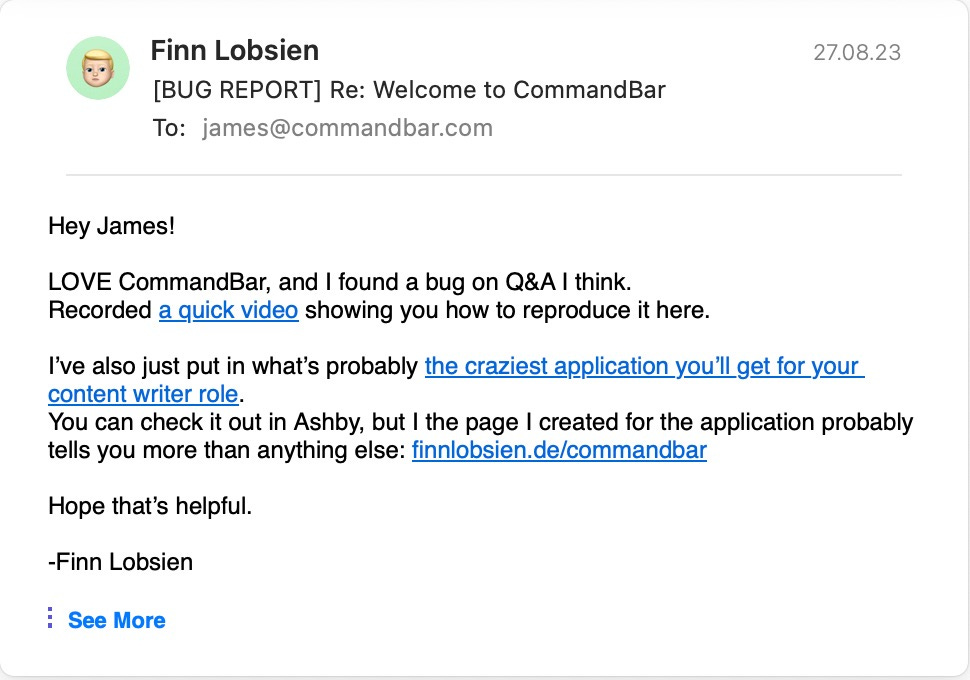
It was a simple email I spent about 2 minutes on, but I’d spent dozens of hours on the application. I sent the email hopeful, but not exuberant. I’d been burned before, spending hours on applications just to get ghosted. I started to doubt myself — was I insane to try to switch jobs during peak layoff season?
I went to bed, both nervous and excited for the response.

20 days later, I started at CommandBar (now Command AI). A few months after that, I found out the position had already been filled, but extra room had been made for me. And now, a year into working at CommandB… AI, it’s the best place I’ve ever worked at.
It's the craziest application I’ve ever created — but also the most laborious one. If you’re at a crossroads in your career, want to enter a new field or just need a change of work environment, you might be wondering what that application was.
In this article, I’ll walk you through the application, why it worked and the lessons you can copy for yourself to land a role you’ll love.
First, I believe there are 3 approaches to good applications:
- Stellar resume: If you have Stanford/Ivy League and big tech on your resume, you’ll get pretty far with generic applications. If you don’t have a stellar resume (if just because the impressive things you’ve done don’t work well on resumes), it’ll be hard — especially because a ton of roles get filled via referrals, not applications from strangers.
- 15 extra minutes: This is the 80/20 version: Spend a few extra moments recording a Loom video about the company’s product, website, etc. If you’re an engineer, maybe find a bug and outline a fix. If you’re a marketer, review the copy on the landing page. etc. This will set you apart from 90% of people.
- 15 extra hours: This is what I did — it’s where you do something crazy and spend a ton of time on a great application. This will set you apart from literally everyone else.
First, my application:
The unhinged application that helped me work at a fast-growing startup
If my intro kept you curious about what the application actually was, it’s still live here (ignore the random Command AI Nudges, I used my website as a testing ground lol).
Here’s the first thing you see when you hit the page:
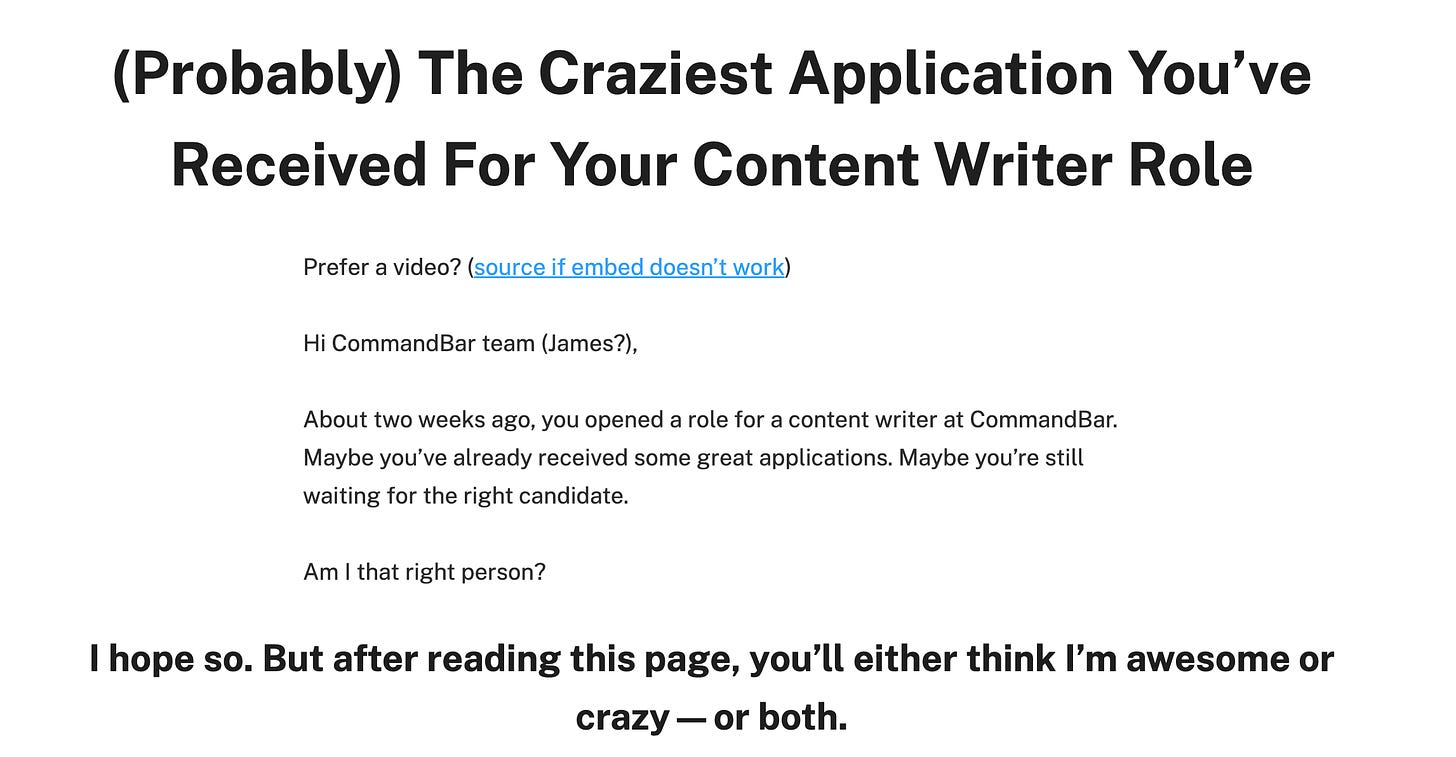
Is this obnoxious? Yes. Did it work? Also yes. But if you want to stand out, by definition, you’ll need to do something differently.
The application continues with a few basics like why I want to work at CommandBar, what makes me qualified, etc.
But then comes the crux of it:
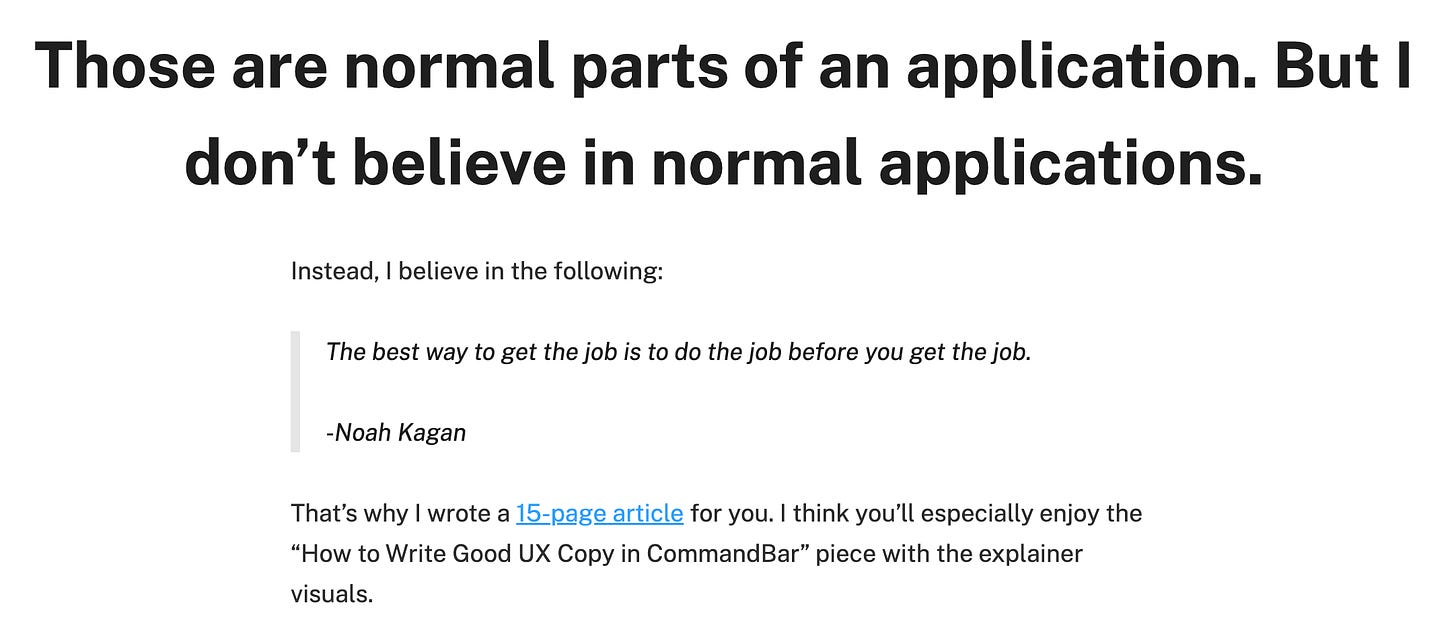
Yep, I wrote a whole damn article without ever talking to anyone. And then I backed it up.
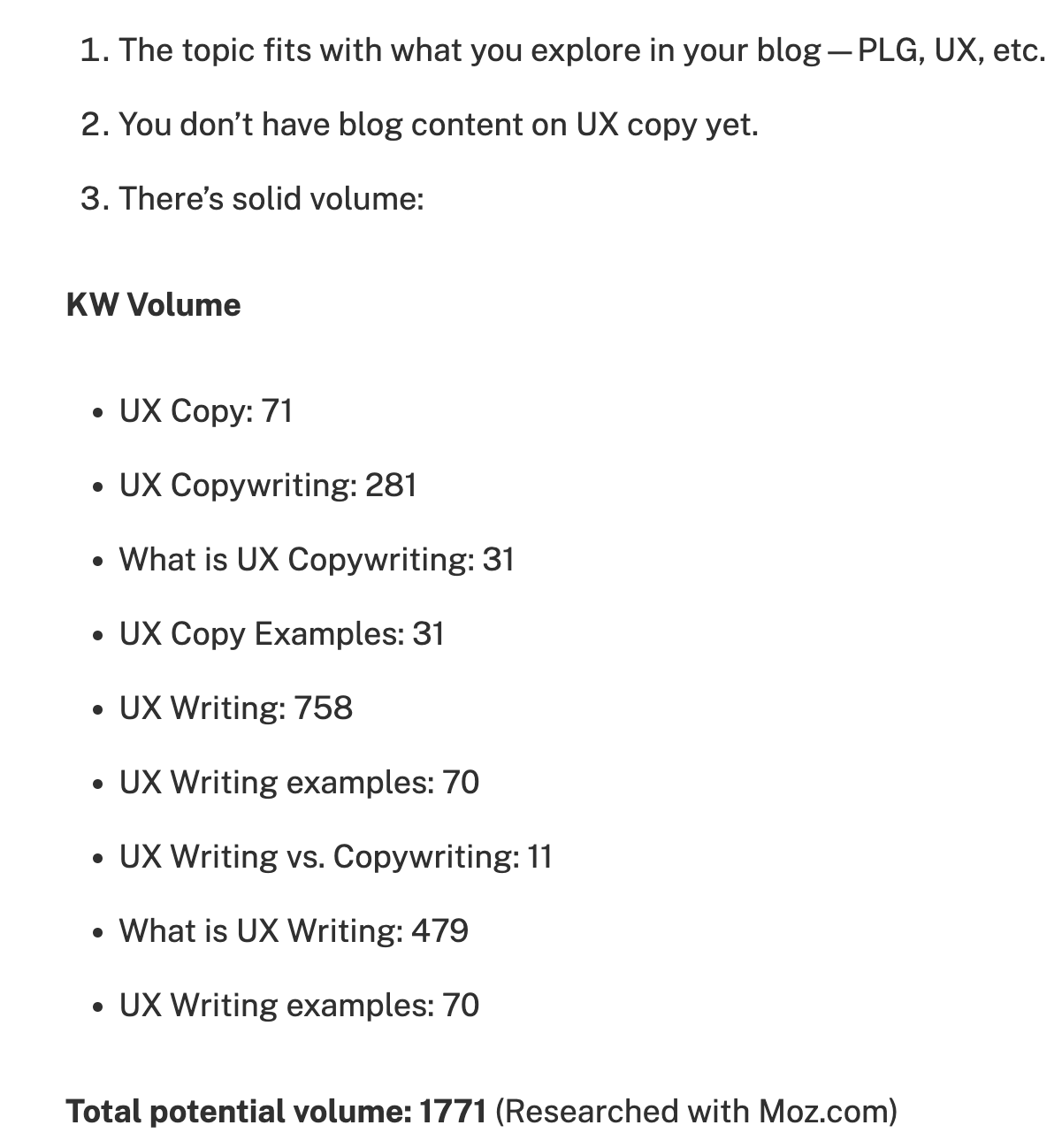
I did this because the job description listed SEO skills as something useful. It also mentioned ability to repurpose for social media, so I created on-brand (at the time) social media images lie this:
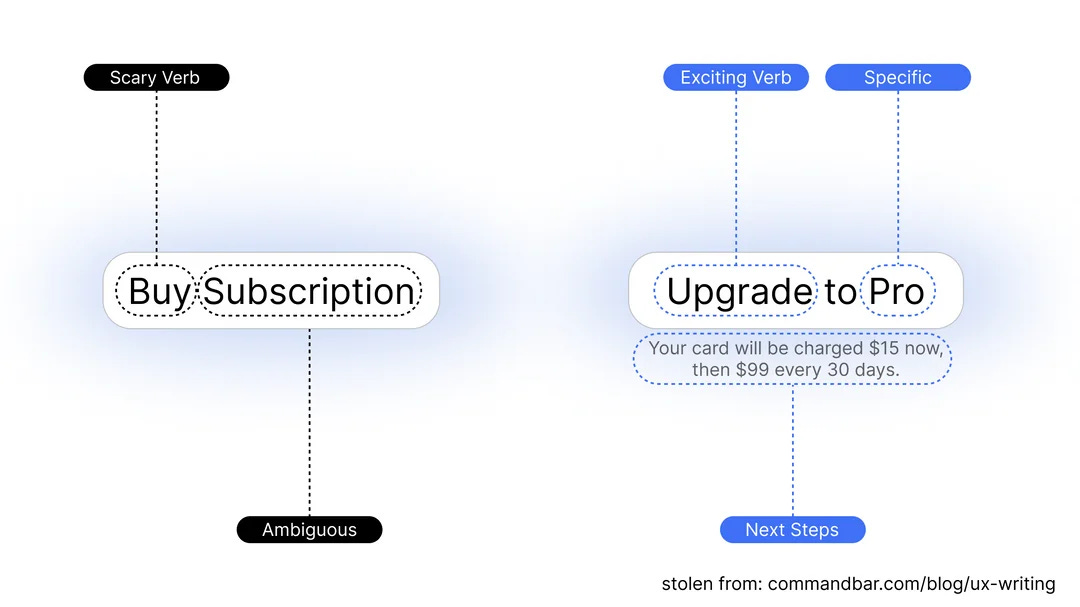
Both of this worked after I joined the company:
- The image is the all-time top post in r/uxwriting.
- The article is one of our better-performing SEO articles.
Another part (that’s now harder to find because I unshipped some of it) was that I actually installed the product on my website — and shipped a ton of widgets with it.
It had:
- A checklist for “hiring your new content writer”
- A HelpHub trained on both the job description and some things I wrote about myself.
There was also some miscellaneous stuff:
- Documentation on how I like to work.
- A video overview on my thinking behind the work I’d done on the article.
- 10 ideas for marketing things CommandBar could do.
(These were cool, but not crucial. Once you’re using your own website instead of a 1-page PDF, you have infinite space, so you can just add fun stuff like this).
Here’s why it worked:
Why unhinged applications work (and when they don’t)
There’s a Mitch Hedberg joke about a hotel that didn’t take cash:
"No man... this (the $) is what the credit card represents. That would be like if you hired a Frank Sinatra impersonator and Frank Sinatra showed up and you were like 'No man, we hired the impersonator.'"
The conventional resume/cover letter needs to represent your ability to excel at the job and company. But it’s hard to compress a career into two documents, especially if it was unconventional like mine. I started my career by launching a freelance business at 18 years old, dropped out of college, etc.
I have a ton of relevant experience, but that’s hard to see from bullets in a resume. So if your career is a winding path (not a straight highway), you won’t win in the resume game. Instead, you need to do the opposite.
Subscribed
The best way to ensure your best shot at getting a job is to apply by just doing the job. Act as if you already got hired and produce something.
If conventional applications are intended as proxies for your ability to excel at the job, this is a more direct way of showing the ability to excel at the job. That’s an obvious insight, but almost nobody does it. An obvious corollary to the obvious insight is that this will only work if the company values quick action, ownership and thinking outside the box.
You might be worried hiring managers will think you’re crazy and reject you. Which might happen! But to quote Sam Altman: “Extreme people get extreme results.”, so you’ll either get rejected instantly or enter an expedited application process.
Step 1: Find the right opportunity
This type of application won’t work everywhere or for every role. Here are the boxes the role should check:
- You should be really excited! If you’re not, you won’t have the stamina to work for hours.
- The company should value the qualities you’re about to exhibit — outside the box thinking, ownership, proactivity, etc. This typically translates to early-stage startups, but doesn’t have to.
- You should be a good candidate. You’ll still need to do interviews, so don’t bluff.
For an example of what to look for:
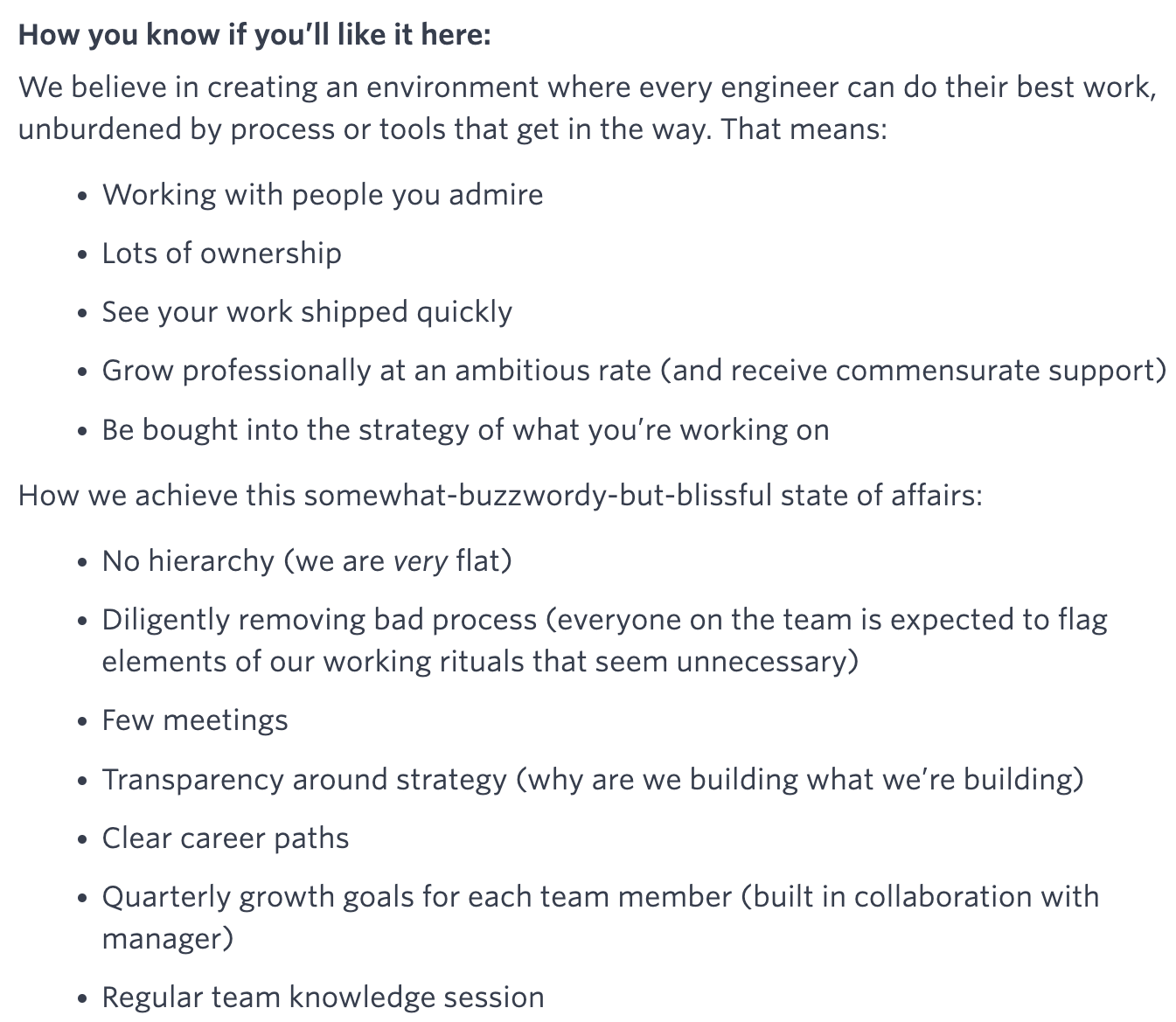
A lot of these things are green flags for your unhinged application: Growth, no hierarchies, ownership, shipping quickly…
What about if you’d love to work for a company, but don’t see a role? Those “don’t see your role here? Apply anyway” types of job listings? It’s a risk, but possible. I’ve never tried, but I reckon this type of application is the best way to get it.
Planning your application
Okay, let’s assume you’ve found a role you’re excited about. This gives you a precise inventory of things to demonstrate. Let’s use another example from our Command AI careers page:
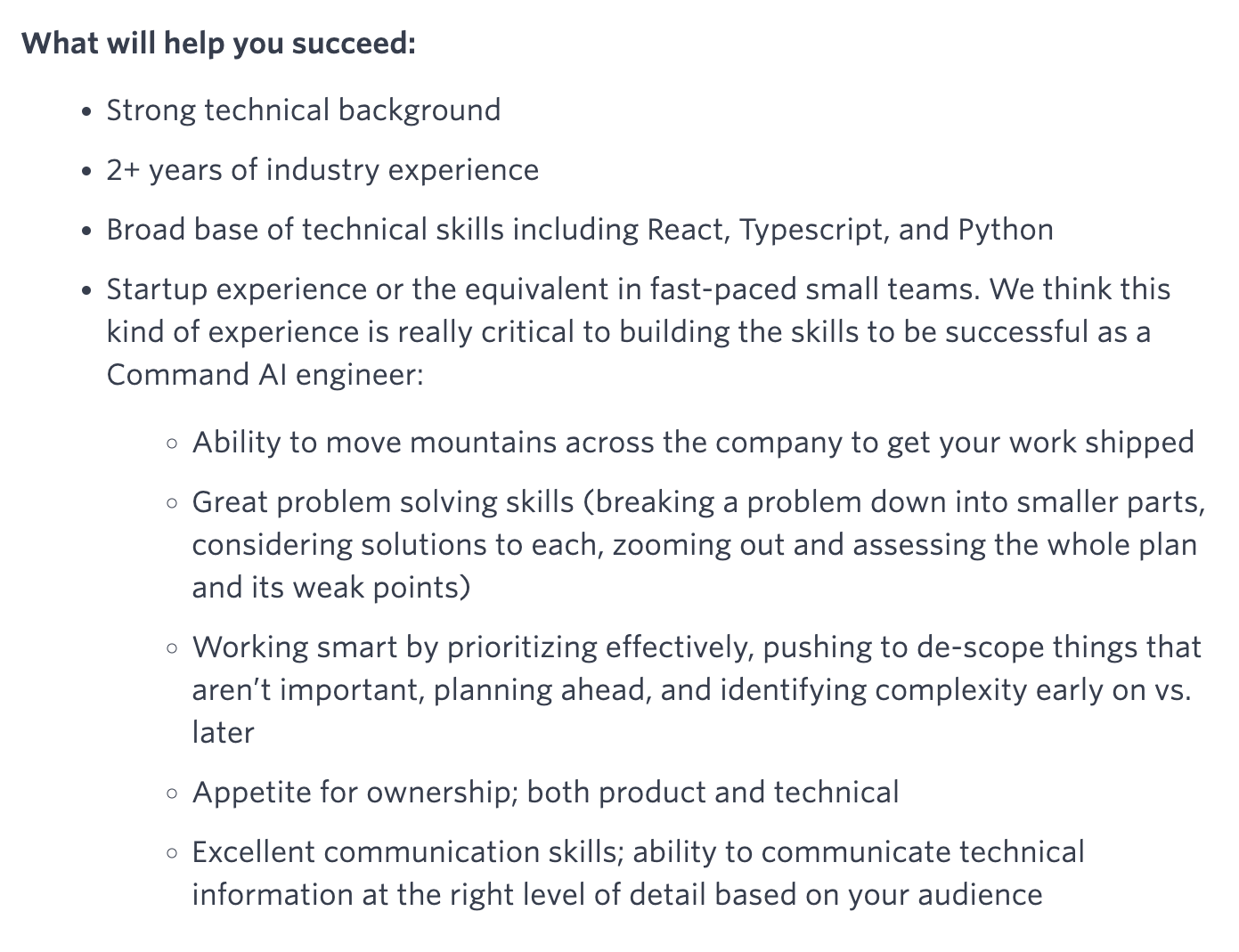
This is effectively a to-do list. The company is telling you what to demonstrate in your application!
Do the research
Most people’s research skims the surface. They look at the products for 5 minutes and squeeze some perfunctory knowledge into their application, maybe connecting with the hiring manager on LinkedIn.
You need to go deeper. Read 10 blog articles, maybe 20 (ideally first-person narratives like stories from the company). Read the founder’s social posts. Listen to podcasts people from the company have been on. Dig up what you can find. The more obscure, the better: People will be impressed when you reference facts they themselves may have forgotten.
Here’s an example from me:

James had tweeted (years ago) about a coffee grinder spilling coffee flakes on his counter. This might be a quirky example, but it shows that I’ve done my research.
The more obscure the facts you can usefully reference, the more of an impression you’ll make. As part of your research — if you can do it at all:
Try the damn product!
Use the free plan, get on the trial, pay for a year, order the physical thing. Knowing the product will increase your chances. Ideally you can use the product in your application somehow — as I did with CommandBar widgets.
(I know this isn’t feasible for all the products out there — like enterprise tech — but will be for many).
Some ideas:
- Task management software: Build out your tasks for their application in their software.
- Documentation software? Build the whole application in it!
- Authentication software? Use it to create a protected section of your website to access the application!
This improves your application, but also makes you a better candidate because it shortens your on-ramp because you already get the product.
If you balk at the idea of spending money on an application, I get it. But: At small companies, your name will likely pop up in Slack as a new customer, which familiarizes your name. There’s also the psychology thing of reciprocity. And for many companies, it’s a great test for how excited you are about the product — would you yourself pay for it? Of course, you won’t always be in the target market, but it’s often a great test.
Creating the artifact
The best way to get the job is to do the job before you get the job.
-Noah Kagan
The best heuristic for the artifact is to pretend you already have the job and complete a project. Lean into what you found out in your research — and explain your reasoning, referencing your research.
This is easiest if you’re applying to a position with concrete deliverables — i.e. designer, writer, engineer, etc. because the things you’ll be creating in your job are so discreet.
If you’re a writer, write something that would fit within the strategy. If you’re an engineer, build an MVP of a cool product feature. If you’re a designer, redesign a screen or flow (or create something net-new). For a product manager, create a product spec. For a marketing manager, create a content calendar complete with ideas and a Notion dashboard you’d use to run the operations. etc.
This is where you reference back to your research, where the product is going. It’s where you reference the job description and make sure you check all the skills boxes.
Why this should take a lot of work
One of the annoyingly important parts of this is effort. You’re trying to blow people away, not mildly impress them.
This is not mostly not about the company the artifact you make. Maybe you’ll actually ship the thing as I did, but the main thing is the message below the message. It’s that you’re willing to spend that amount of time on your application because you want to work there so badly.
It’s like giving someone flowers.
‘[Women] know that men have no use for [flowers], but that the men have spent money on something that only benefits the woman.
Hence when you give flowers to your wife, you have spent money on something which does nothing for you but which makes her deliriously happy: it demonstrates a willingness to incur a cost purely for her benefit."
-Rory Sutherland
This is similar: It’s precisely that you sent them something you didn’t just have lying around on your hard drive that makes this meaningful (else that’d be called a portfolio).
Of course, this is also an opportunity to practice your craft. And if it doesn’t work out, it’s a project to add to your portfolio. And if you apply to a similar company, you might even be able to reuse it.
Once you’re done creating the artifact, create a Loom video to explain why you did everything. Walk the person seeing it through your reasoning and reference the research you did. This a) creates familiarity with your face and voice and b) lets the hiring manager see your brain at work, not just the results.
But if you’re spending all this time, you want to make sure people will see it, right?
How to make sure people see your application
Many (most?) applications never get looked at. So don’t just attach all the work you did as a resume.pdf and call it a day.
You want to submit a regular application, yes. But you need to do more.
A few channels:
- Reply to newsletters/emails you get from the company: At most startups, these email addresses are actually monitored, but get few replies — so you’ll actually stand out.
- Find out people’s emails: Try common email schemes like firstname@company.com.
- Connect with the people you’d be working with on LinkedIn and send it to them.
- If the company has a community (Slack/Discord usually), join that and send it to people working at the company.
- [last resort only because this is annoying] Submit a support ticket.
Some of this might sound like you’d be annoying. You won’t. You’ve already gone far outside what’s normal, so don’t start doing things the conventional way at this point.
After sending your application
You’ll likely a fast response with an invitation for an interview — or you’ll never hear from them. An outrageous application like that will rarely get mild interest.
But don’t expect the company to hire you off of your application alone. You’ll probably still go through an application process. That means interviews and it can mean take-home exercises.
There’s a sense of entitlement some people might have around this: I’ve already done all of this work for free, why should I do even more?
But entitlement will kill your chances. All you can expect is to be treated as a great candidate. The reason this works is because you’re trusting them to be great to work with — so much so that you’re willing to trust first.
Wrapping up
And that’s how you get a job at a startup. I did this 3 times before it worked out. One time I was ghosted. One time I made it to the final interviews. One time I got hired.
But each time, I got to do work I genuinely enjoyed. And I got a dream job out of it. Follow my playbook if you want to do the same.

















